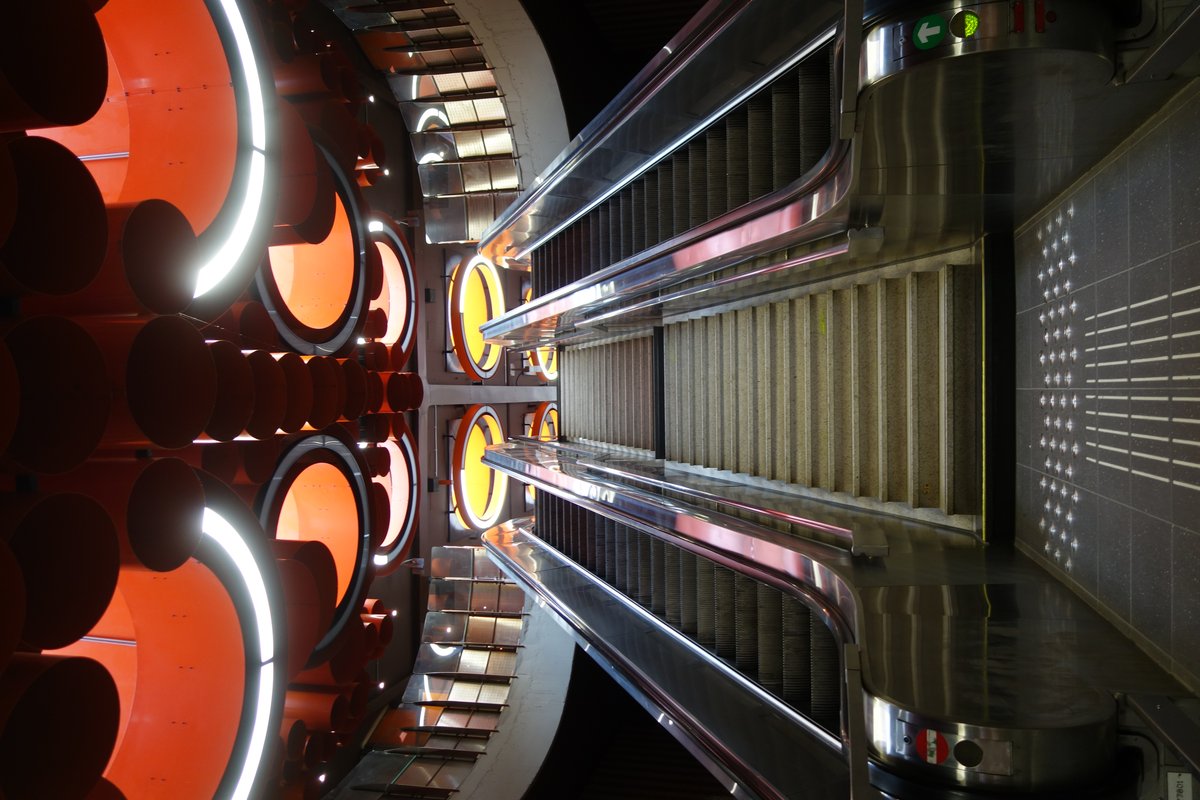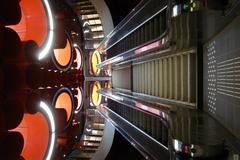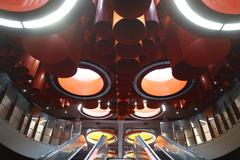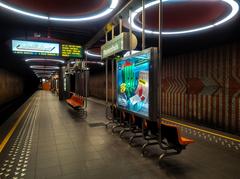
Pannenhuis Metro Station: Visiting Hours, Tickets, and Guide to Brussels’ Historical Sites
Date: 15/06/2025
Introduction: Pannenhuis Metro Station’s Role in Brussels
Pannenhuis Metro Station, located in the Laeken district of Brussels, is a remarkable example of how public transportation infrastructure can blend historical relevance, innovative architecture, and urban connectivity. Since its opening in 1982 as part of the Beekkant–Bockstael metro extension, Pannenhuis has transformed from a functional transit node into an architectural icon, distinguished by its minimalist, daylight-rich design and vibrant orange-and-white mosaics. As a protected heritage site since August 2024, Pannenhuis now serves both as a commuter hub on Metro Line 6 and as a cultural destination, offering access to major attractions like the Atomium, Basilica of the Sacred Heart, and Royal Greenhouses. This comprehensive guide details everything you need to know about visiting Pannenhuis Metro Station, from its history and architecture to tickets, accessibility, and nearby sites.
For the latest schedules, ticketing, and updates, consult the official STIB/MIVB website and visual resources from Monument Heritage Brussels.
Table of Contents
- Historical Background
- Architectural and Artistic Features
- Heritage Status and Urban Impact
- Visitor Information
- Photography Tips
- Frequently Asked Questions (FAQs)
- Conclusion
- Sources
Historical Background
Origins and Urban Context
Pannenhuis Metro Station sits in Laeken, a district marked by royal heritage and a strong industrial past. Its strategic location near Pannenhuisstraat and the Charles Demeerstraat bridge underscores its role in connecting the city’s northern neighborhoods. The station’s position alongside major railway lines further cements its importance in Brussels’ urban transit system.
Construction and Opening
Inaugurated on October 6, 1982, Pannenhuis was part of a significant metro expansion that included stations like Bockstael, Belgica, Simonis, and Ossegem. Designed by Vincent Dehon and completed in 1988, the station exemplifies functionalist design, prioritizing accessibility and natural lighting.
Metro Services Evolution
Pannenhuis originally served line 1A but became part of line 6 after the 2009 metro network reorganization. Line 6 forms a loop around central Brussels, facilitating seamless travel between city districts and major landmarks.
Architectural and Artistic Features
Design and Spatial Experience
Pannenhuis Metro Station is renowned for its futuristic, cinematic architecture. The station employs bold orange and white mosaics, stainless steel cones, and oval lighting fixtures that together create a visually striking environment. The high ceilings, tubular forms, and circular skylights allow ample daylight to filter through, reducing the subterranean feel and enhancing spatial dynamics. The interplay of natural and artificial light produces a dramatic atmosphere, making Pannenhuis one of the most photogenic and “Instagrammable” metro stations in Brussels (thehotel-brussels.be).
Artistic Integration
While the station does not feature standalone public artworks, its entire architectural composition—including its color schemes, lighting, and geometric motifs—functions as an immersive work of art. This approach reflects Brussels’ broader commitment to integrating art into public infrastructure (alternativespots.com, givinggetaway.com). The design democratizes art by making it accessible to all metro users with a standard ticket.
Heritage Status and Urban Impact
On August 19, 2024, Pannenhuis Metro Station was officially added to the Brussels-Capital Region’s legal inventory of protected sites, recognizing its significance in the city’s late 20th-century urban expansion. The station has contributed to neighborhood regeneration in Laeken and Jette, transforming former industrial areas into vibrant mixed-use communities.
Visitor Information
Operating Hours
- Monday–Thursday: 5:30 AM – 12:30 AM
- Friday–Saturday: 5:30 AM – 2:00 AM
- Sunday: 5:30 AM – 12:30 AM
Pannenhuis operates during regular Brussels Metro hours, with trains every 6–10 minutes during peak times and every 10–15 minutes off-peak (STIB/MIVB).
Ticketing
- Ticket options: Single-journey (€2.10 as of June 2025), day passes, and multi-ride cards.
- Where to purchase: Station ticket machines (accepting cash, card, and contactless), STIB/MIVB app, and official counters.
- Validation: Validate your ticket at entry gates before accessing platforms.
Accessibility
Pannenhuis offers step-free access with elevators, ramps, and tactile paving for visually impaired users. Audio announcements and multilingual signage (French, Dutch, English) further enhance accessibility. Passengers with reduced mobility can reserve assistance in advance by contacting STIB/MIVB (Wheelchair Travel).
Travel Tips
- Avoid peak rush hours (7–9 AM, 4–6 PM) for a more relaxed visit.
- Use contactless payment or mobile apps for efficient ticketing.
- The station’s daylight features are best experienced during mid-morning or early afternoon.
- No luggage storage is available at Pannenhuis; use major stations like Gare du Midi for storage needs.
- Expect frequent rain in Brussels; carry an umbrella or raincoat (Wanderlog).
Nearby Attractions
- Atomium: Iconic steel structure and museum, reachable via a short metro ride or a 20-minute walk (The Tejana Abroad).
- Basilica of the Sacred Heart: One of the world’s largest Art Deco churches, accessible by metro with a transfer at Simonis.
- Eglise Notre-Dame de Laeken: Neo-Gothic church with the Belgian royal crypt, within walking distance.
- Laeken Royal Greenhouses: Open seasonally, featuring rare botanical displays.
- Local cafés and bakeries: Enjoy Belgian cuisine and local specialties in the surrounding area.
Photography Tips
The escalator area, with its high ceilings and dramatic lighting, is ideal for capturing the station’s futuristic look. Natural light is best between late morning and early afternoon, offering dynamic shadows and color contrasts. Photography is permitted, but be mindful of fellow passengers and safety regulations (alternativespots.com).
Frequently Asked Questions (FAQs)
Q: What are the operating hours of Pannenhuis Metro Station?
A: Monday–Thursday 5:30 AM–12:30 AM, Friday–Saturday until 2:00 AM, Sunday until 12:30 AM.
Q: How much does it cost to visit?
A: Standard metro ticket (€2.10); no extra fees for station entry or photography.
Q: Is the station accessible for travelers with disabilities?
A: Yes, with elevators, ramps, tactile paving, and audio announcements. Assistance can be reserved in advance.
Q: What attractions are nearby?
A: Atomium, Basilica of the Sacred Heart, Eglise Notre-Dame de Laeken, Royal Greenhouses.
Q: Are there guided tours at the station?
A: No official guided tours, but some city tours include Pannenhuis as an architectural highlight.
Visuals
Conclusion
Pannenhuis Metro Station exemplifies how Brussels integrates architectural artistry, cultural identity, and functional transit within its urban landscape. Its protected status, unique daylight integration, and proximity to major attractions make it a must-visit for both commuters and tourists. For the most current information, refer to the STIB/MIVB website, Brussels tourism portal, and Monument Heritage Brussels.
Download the Audiala app for real-time updates, travel planning, and additional city guides.
Sources and Further Reading
- This is a sample text. (https://monument.heritage.brussels/fr/buildings/41701)
- This is a sample text. (https://bruxellessecrete.com/pannenhuis-station-metro-bruxelles/)
- This is a sample text. (https://thetejanaabroad.com/the-most-instagrammable-spots-in-brussels/)
- This is a sample text. (https://www.stib-mivb.be)
- This is a sample text. (https://www.thisiscolossal.com/2025/06/thibault-drutel-symmetric-subway/)
- This is a sample text. (https://www.visit.brussels/en)






































































































































